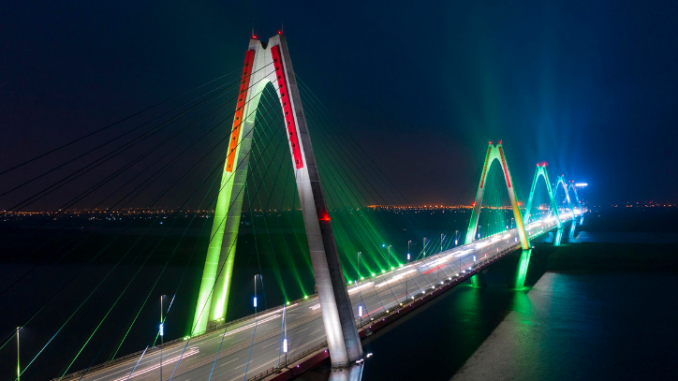
The works of Turtle Tower, Tran Quoc Pagoda, or Nhat Tan Bridge are quiet under the night lights, in contrast to the crowded daytime.

Thanh Nien Street is brightly lit when viewed from above, connecting the West Lake and Truc Bach Lake. On the right side of the road (photo) is Tran Quoc Pagoda, in the far side are high-rise buildings with bright lights.

Tran Quoc Pagoda reflects the reflection of West Lake at about 7:00 p.m.
The pagoda has a history of 1,500 years, was the Buddhist center of Thang Long citadel in the Ly and Tran dynasties. The work was recognized as a national-level historical and cultural relic in 1962. In 2003, the pagoda held the inauguration of the 15-meter-high and 11-storey lotus pagoda of Luc Do. In 2016, the Thrillist site voted Tran Quoc Pagoda as one of the most beautiful religious buildings in the world.

Long Bien Bridge shines brightly with lights, reflecting into the Red River at night.
On February 25, 1902, the 1,691 meter long bridge was inaugurated, not only the first artery iron bridge connecting the Red River banks, but also an integral part of the capital’s history.
Initially the bridge was named Doumer, after the governor general of Indochina at that time – Paul Doumer. By 1924, the scale of the bridge was expanded as it is now. In early April, the damage on the bridge was checked and repaired and included in the regular maintenance plan.

Bat Giac building (also known as the trumpet house) built in 1901 is the place for the French army’s trumpets to perform, in the Ly Thai To flower garden area, located close to Sword Lake, located between the streets of Dinh Tien Hoang and Le. Lai, Le Thach and Ngo Quyen.

Turtle Tower, the “heart” of Hanoi capital, reflects a light on the face of Sword Lake. The lake is surrounded by three streets: Hang Khay, Le Thai To and Dinh Tien Hoang. This is an area that any visitor to Hanoi wants to visit at least once.

St. Joseph’s Cathedral was taken 3 vertical panoramas, seeing the church architecture, fence, flower basin and statue of Our Lady of the Church. The project is located at the intersection of Nha Chung Street, Ly Quoc Su and Nha Tho Street, just 200 meters from Hoan Kiem Lake.
The work was built in the years 1884 – 1887, bold French architecture with high walls, dome and many windows. This is one of the important churches of Hanoi Catholics and a place where many tourists visit and take pictures.

Section under Chuong Duong bridge fanciful in traffic lights at night through wide angle and exposure techniques.
Chuong Duong Bridge, consisting of two lanes for cars and one motorbike lane, was inaugurated on June 30, 1985, across the Red River, connecting the center of Hoan Kiem district with Long Bien district. From 1985 up to now, Chuong Duong bridge plays an important role in transport and economic development of the capital.

Bang Pagoda, also known as Linh Tien Tu has a history of over 400 years, is located in Bang Liet Street, Hoang Liet Ward, Hoang Mai District. In the temple precinct there is Bao An stupa, the work inheriting the meaning of Bao Thien in the Ly Dynasty.

Hanoi Museum, located in the Vietnam National Convention Center, is located at Pham Hung Street, Me Tri Ward, Nam Tu Liem District. The building was completed in 2010, with an inverted pyramid architecture, in which the 4th floor has the largest area and the lower floors are smaller. This is the 1,000th anniversary work of Thang Long.

The view of the Landmark 72 building and the magical high-rise buildings in the night fog.

The butterfly-shaped intersection glows in the night, creating a unique beauty for the Truong Sa – Hoang Sa route intersecting with Vo Nguyen Giap street in Vinh Ngoc commune, Dong Anh district.
With 6 lanes running, Vo Nguyen Giap street started construction in August 2012, inaugurated in early 2015 with Nhat Tan bridge, T2 terminal and VIP guest house at Noi Bai airport. When going from the inner city to Nhat Tan bridge, visitors will meet this intersection.

Nhat Tan Bridge many colors in the night. This is the longest cable-stayed bridge over the Red River, connecting Dong Anh district and Tay Ho district. The main bridge section is 3.7 km long with a 5-tower continuous cable-stayed design, the path section is 5.1 km long, 60 m wide with 4 lanes. The bridge helps shorten the distance from the center of Hanoi to Noi Bai airport. Follow vnexpress
Photo: Nghiem Dinh Chinh
